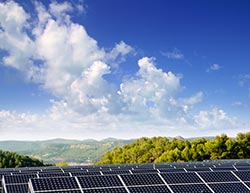Week in review-Good news for solar in desert Southwest, trade war heats up
 Last week perhaps the biggest thing to happen in the U.S. was the Department of Interior’s (DOI’s) finalization of its plan for allowing solar on Bureau of Land Management lands—that or China’s promise to look into U.S. polysilicon trade practices, oh, and the European Union’s decision to look into Chinese silicon PV trade practices. Basically it was a week for moving forward on discussions of the future of solar.
Last week perhaps the biggest thing to happen in the U.S. was the Department of Interior’s (DOI’s) finalization of its plan for allowing solar on Bureau of Land Management lands—that or China’s promise to look into U.S. polysilicon trade practices, oh, and the European Union’s decision to look into Chinese silicon PV trade practices. Basically it was a week for moving forward on discussions of the future of solar.
The DOI released its final Solar Programmatic Environmental Impact Statement (PEIS) that widely praised document which will allow solar companies to install utility-scale solar project on wide tracts of land in the U.S. desert southwest on BLM-managed land in Arizona, California, Colorado, Nevada, New Mexico, and Utah. The PEIS drew praise from industry advocates and environmentalists alike, for its pre-identified Solar Energy Zones, which are pre-designated areas found suitable for solar and the easiest to apply for, as well as the mitigation process through which companies can apply to build solar on other lands.
The solar trade war continues to heat up—and it’s getting uglier. Following the U.S. Commerce Department’s ruling imposing preliminary tariffs on Chinese silicon PV imports to the U.S., China’s Ministry of Finance (MOFCOM) announced that it is launching its own investigation into U.S. polysilicon trade practices. The ministry has launched an investigation as to whether U.S.-based whether suppliers of solar-grade policysilicon from the U.S. and from South Korea have engaged in unfair trade practices with China. The investigation is scheduled to last a year.
Meanwhile, across the pond, the European Union (E.U.) has launched its own investigation into whether or not Chinese PV manufacturers have engaged in unfair pricing and dumping in the European market. Like the complaints in the U.S., the charges were led by SolarWorld and an advocacy organization the company helped found. In the U.S. it was the Coalition for American Solar Manufacturing (CASM). In Europe it is EU ProSun. The coalition of manufacturers aligned with ProSun allege that Chinese photovoltaic manufacturers are offering their PV cells and modules at costs below their manufacturing costs despite their losses. Since Chinese module makers supply a larger segment of the European market that the U.S. market, this could have a more significant impact on Chinese PV manufacturers than the U.S. sanctions, even though some were higher than 200 percent. On the other hand any E.U. sanctions are expected to be lower.
The U.S. House of Representatives is moving forward on the ‘No More Solyndras Act’. The bill passed out of the U.S. House Energy and Commerce Subcommittee on Energy and Power last week. It would end the Department of Energy’s Loan Guarantee program, which has been successful in getting utility-scale solar projects into the ground, but less successful with supporting domestic manufacturing of new photovoltaic technologies. It’s the latest move in a string of Republican efforts to remind the American public that Solyndra failed after receiving a $535 million loan guarantee, approved by the Department of Energy during the Obama Administration.
While the manufacturing side of the solar industry is still facing those stormy bulkheads, the installer’s side continues to move forward. For instance, last week Credit Suisse developed a new $200 million facility to support SunRun’s growth. The new fund will allow SunRun to install solar on thousands of homes throughout the U.S. in states that it operates in. Companies like SunRun, Sungevity and SolarCity have quickly gained popularity and marketshare throughout the U.S. because they’re able to offer homeowners solar installations at little to no up-front costs in exchange for a solar lease or power-purchase agreement.



